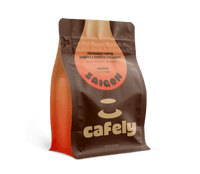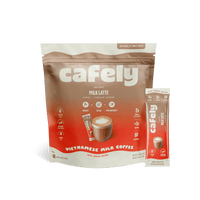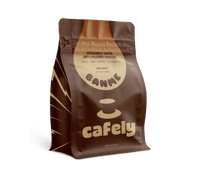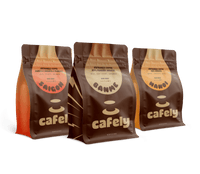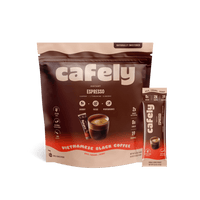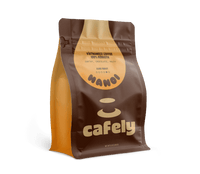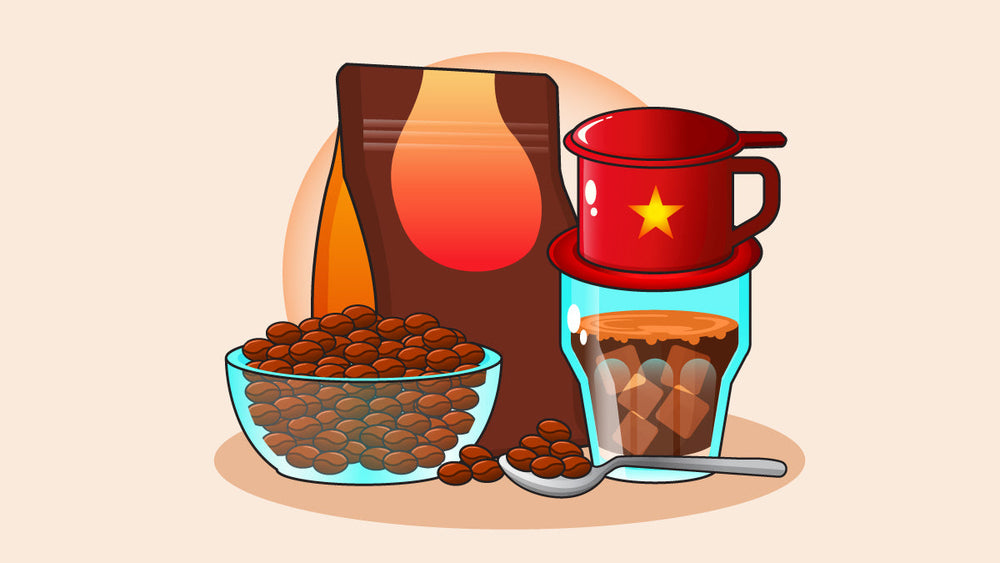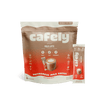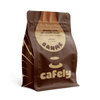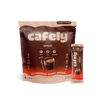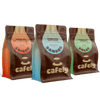Vietnamese coffee is one of the fastest-growing markets in the coffee scene, with more and more people around the world looking to get in on the action. But, with it being so different from Western coffee, how do you know what to expect and what to look for?
We’ve put together what you need to know about Vietnamese coffee, from bean types to roasting methods, what to look for when purchasing, and where to buy the best.
What is Vietnamese Coffee?
Vietnamese coffee refers to any kind of coffee that is grown in Vietnam. Mainly grown in the wet central highlands, Vietnamese coffee production is primarily composed of robusta beans rather than arabica.
You may also hear the term used to refer to coffee served with sweetened condensed milk, as this is the most common way to drink coffee in Vietnam.
Where to Buy Vietnamese Coffee Beans
Vietnamese coffee is a growing market in the US, so you might not see it on your grocery store shelves just yet. However, you may find it at stores such as Asian markets or specialty coffee shops.
The easiest place to buy it is online.
Check out Cafely’s selection of high-quality Vietnamese coffee beans:

- DaNang Coffee (Arabica x Robusta)
- BanMe Coffee (100% Peaberry Robusta)
- SaiGon OG Coffee (Robusta x Arabica X Peaberry)
- HaNoi Coffee (100% Robusta)
- DaLat Coffee (100% Arabica)
To get a taste of what Vietnamese coffee has to offer, try Cafely’s Vietnamese Harmony Coffee Trio, which comes with a bag of DaNang, SaiGon OG, and DaLat coffee.
Cafely also carries a range of Vietnamese instant coffees, including traditional milk coffee, coconut coffee (dairy-free), and black (extra-strength).
Where to Buy Traditional Vietnamese Butter Coffee
In Vietnam, roasters would typically glaze the dried beans in butter or rice wine prior to roasting. This helped enhance the roasted, chocolatey, nutty flavors of the beans to produce a stronger cup.
It’s hard to beat the intensity of flavors authentic Vietnamese butter coffee has to offer.
Not many companies butter roast their coffee anymore, but Cafely continues this tradition in their SaiGon OG blend.
Buy traditional Vietnamese coffee beans from Cafely: SaiGon OG Blend.
Where to Buy Vietnamese Robusta Coffee
Robusta coffee (Coffea canephora) is the most widely grown type of coffee in Vietnam. In fact, the country produces the most robusta coffee in the world.
While arabica coffee plants tend to thrive only at high altitudes and in certain conditions, robusta coffee plants can make themselves at home in the lower regions with no issue.
High-quality robusta contains almost double the amount of caffeine than arabica, and the flavors are bold and punchy, including bitter, chocolatey, and earthy notes.
Buy Vietnamese robusta from Cafely: HaNoi 100% Robusta Coffee.
Where to Buy Vietnamese Arabica Coffee
Although robusta is the star of the show in Vietnam, the country still produces some amazing arabica (Coffea arabica). You can find it growing in the central highlands, in particular around the Lam Dong region.
Vietnamese arabica coffee has a much more subtle flavor than robusta, with mild, pleasant acidity and notes including citrus, caramel, and even floral hints.
Buy Vietnamese arabica coffee from Cafely: DaLat 100% Arabica Coffee.
Where to Buy Vietnamese Culi Coffee (Peaberry)
Peaberries (AKA “Culi Coffee” in Vietnam) are a rare coffee bean that occurs due to a natural mutation in both robusta and arabica coffee. No more than 10% of a given crop consists of the cherished and intensely potent peaberries.
Normally, a coffee cherry (the fruit surrounding what we know as the coffee bean) contains two seeds. But, if the peaberry mutation occurs, the cherry will only contain a singular seed.
Peaberry coffee is prized by coffee lovers, who describe the taste as being much sweeter, more flavorful, and more intensely caffeinated than its counterparts.
Buy top-tier Vietnamese Culi (peaberry coffee) from Cafely: BanMe 100% Peaberry Coffee.
How to Pick the Best Vietnamese Coffee Beans

When you are deciding which Vietnamese whole coffee beans to buy, here are a few things to look out for and consider:
The Type of Coffee
There are 2 main species of coffee used today — robusta and arabica. It’s important to know what type of coffee you want before you buy.
Robusta coffee is the most typical form used to make Vietnamese iced coffees. These beans have a stronger flavor and higher caffeine content, which pairs perfectly with the sweet condensed milk, ice, and lower volumes used to make Vietnamese coffee drinks.
Related: How much caffeine is in Vietnamese coffee
Coffee Origin
True “Vietnamese coffee” has to come from Vietnam — but this doesn’t mean that robusta blends from other countries can’t be used to make great Vietnamese-style coffees.
For a truly authentic experience — make sure the coffee comes directly from Vietnam.
The Freshness of the Beans
One of the most important things to check is how fresh the beans are. The more recent the roast date, the better the flavor.
You might be able to find the roast date on the packaging, or it may be listed on the product page. If you can’t find it, we recommend calling or emailing the supplier to check using the batch # included on the package.
The Roast Level & Method

Vietnamese coffee has a very distinct roasting method that sets it apart. Usually, it is roasted very dark and typically coated with butter prior to roasting for an extra boost in flavor.
Flavor Notes
Subtle differences in climate, soil conditions, and farming techniques can have a dramatic impact on the subtle nuances of a particular coffee bean.
Most companies will list the tasting notes directly on the package to help customers pick the beans that pique their interest.
The taste of Vietnamese coffee often has hints of caramel, chocolate, malt, cherry, citrus, nuts, and pepper.
Grind Level
Generally-speaking, we recommend people order whole-bean (non-ground) coffee and grind it just before brewing so it preserves as much freshness as possible. However, we know many people don’t have a grinder, and don’t mind trading a little bit of flavor for convenience, so we sell both whole-bean and ground coffee in all styles.
If shopping for ground coffee, consider the brewing method you plan to use. Make sure to get a grind that matches the brewing device you’re using at home.
For reference, we grind all our coffee to medium-fine — which is perfect for use in the traditional Vietnamese phin filter.
Grind levels for different coffee brewing systems:
- Fine Grind —AeroPress brewer, Espresso machine
- Medium-Fine Grind —Moka pot, Phin filter
- Medium Grind –Drip Coffee maker
- Medium Coarse Grind —Chemex brewer, Hario V60
- Coarse Grind — French press, Cold brew, Percolator
FAQs: Buying Vietnamese Coffee
Still want to know more? Here are some more questions and answers surrounding Vietnamese coffee.
1. What’s the best way to prepare Vietnamese coffee?
The best way to prepare Vietnamese coffee is the traditional way by using a phin filter, a small metal filter that sits on top of the cup. It allows the water to seep through slowly, creating a thick and strong coffee that pairs perfectly with sweetened condensed milk.
2. Is Vietnamese coffee expensive?
Compared to grocery stores or mass-market coffee, Vietnamese coffee will be more expensive to buy, but not massively so. However, the quality and taste you get for the slightly higher price tag is often well worth it — especially if you’re buying coffee in large amounts, where bulk purchases often provide better value per cup.
3. Why is Vietnamese coffee so strong?
Vietnamese coffee can be a shock to the system if you are not used to it! This is because it’s primarily made with robusta, a much stronger and more caffeinated type of coffee than arabica.
4. What’s the best way to drink Vietnamese coffee?

The best way to drink Vietnamese coffee is how the locals do it: filtered slowly through a phin with some sweetened condensed milk. The milk helps to balance out the strong flavors, making for an addictive caffeine hit.
5. What’s a good beginner Vietnamese coffee blend?
For first-time Vietnamese coffee drinkers, a blend of robusta and arabica beans can be a great gateway into this new coffee experience. This is why our SaiGon OG and DaNang blends are so popular. They offer the best coffee for first-time drinkers by taking the best of both worlds — the bold kick of robusta and the smooth, sweet character of arabica.
6. What makes Vietnamese coffee different from Western coffee?
The main difference between Vietnamese coffee and Western-style coffee is that Vietnamese coffee uses robusta beans and condensed milk. Western coffee uses the milder arabica bean and freshly steamed or frothed milk.
7. How should I store Vietnamese coffee to maintain freshness?
Always store your coffee in an airtight container. Keep it in a cool, dry place, away from direct sunlight or moisture. Avoid storing in the refrigerator as moisture and aromas from the fridge can become trapped in the walls of the coffee bean. Only store your coffee in the freezer if you plan to keep it for more than four months.
8. Are all Vietnamese coffee blends roasted with butter or rice wine?
Not all Vietnamese coffee blends are roasted with butter or rice wine. At Cafely, only the SaiGon OG blend is roasted with butter; all other offerings are conventionally roasted.
9. What type of coffee bean should I choose if I prefer milder flavors?
If you prefer milder flavors, opt for Vietnamese arabica coffee beans. These offer a more subtle taste with notes of caramel, citrus, and floral undertones, providing a smoother coffee experience.
Cafely’s DaNang coffee is a 50/50 blend of Vietnamese arabica and robusta for a more balanced flavor while maintaining the bold intensity Vietnamese coffee is famous for.
